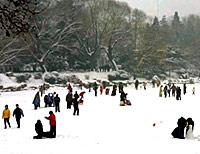|
The Northern hemisphere on this day experiences the shortest
daytime and longest nighttime. After the Winter Solstice, days will become longer and longer. As ancient Chinese thought,
the yang, or muscular, positive things will become stronger and stronger after this day, so it should be celebrated.
The Winter Solstice became a festival during the Han Dynasty (206 BC-220 AD) and thrived in the Tang
and Song dynasties (618-1279). The Han people regarded Winter Solstice as a "Winter Festival", so officials would organize
celebrating activities. On this day, both officials and common people would have a rest. The army was stationed in, frontier
fortresses closed and business and traveling stopped. Relatives and friends presented to each other delicious food. In the
Tang and Song dynasties, the Winter Solstice was a day to offer scarifies to Heaven and ancestors. Emperors would go to suburbs
to worship the Heaven; while common people offered sacrifices to their deceased parents or other relatives. The Qing Dynasty
(1644-1911) even had the record that "Winter Solstice is as formal as the Spring Festival," showing the great importance attached
to this day.

In some parts of Northern China, people eat dumpling soup on this day; while
residents of some other places eat dumplings, saying doing so will keep them from frost in the upcoming winter. But in parts
of South China, the whole family will get together to have a meal made of red-bean and glutinous rice to drive away ghosts
and other evil things. In other places, people also eat tangyuan, a kind of stuffed small dumpling ball made of glutinous
rice flour. The Winter Solstice rice dumplings could be used as sacrifices to ancestors, or gifts for friends and relatives.
The Taiwan people even keep the custom of offering nine-layer cakes to their ancestors. They make cakes in the shape of chicken,
duck, tortoise, pig, cow or sheep with glutinous rice flour and steam them on different layers of a pot. These animals all
signify auspiciousness in Chinese tradition. People of the same surname or family clan gather at their ancestral temples to
worship their ancestors in age order. After the sacrificial ceremony, there is always a grand banquet.
|

